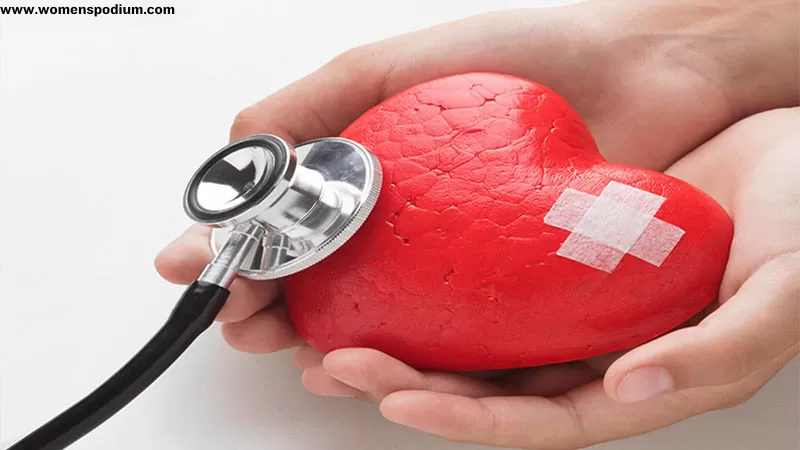
The specific hormonal system of women along-with some social issues and lifestyle habits puts them at a higher risk for certain heart diseases. Women need to address them carefully.
Health is the prime wealth of a woman regardless of her age and gender or any other attribute of her life. It, therefore, requires her utmost attention and care. The healthier she is, the prettier she appears to all, and vice versa. The females’ physique and hormonal system are not as strong as the males. Also, some social issues and, sometimes, their unusual lifestyle make the difference. Hence, they are at more health risks comparatively. Let’s see how different heart diseases in women pose more health risks.
Symptoms That Show Heart Diseases in Women

Most of the symptoms of heart diseases are common in men and women like:
- Heavy or dull or sharp chest pain or discomfort
- Pain in one or both arms
- Pain in the upper abdomen or back
- Shortness of breath
- Frequent dizziness
These symptoms may appear during routine activities or while at rest. Women, in particular, may also show the following symptoms.
- Nausea
- Vomiting
- Fatigue
- Pain in the jaw, neck, and throat
However, sometimes heart diseases in women remain silent, and they are diagnosed only with the advent of the following symptoms.
- Indigestion
- Heartburns
- Swelling of feet, ankles, legs, abdomen or neck veins
- Palpitations or fluttering feelings in the chest called Arrhythmia
It would be best to rush to your doctor or any nearby hospital in an ambulance whenever you feel or observe any of these symptoms.
Coronary Artery Disease and Heart Attack

The accumulation of cholesterol and plaque, called atherosclerosis, results in the narrowing or blockage of the coronary arteries (the vessels that supply blood to the heart muscles), causing the cells of the heart muscles to die. This is called coronary artery disease, which is the primary cause of heart attack in both men and women. This is not a sudden disease. Instead, it takes years for the cholesterol and plaque to accumulate along the inner walls of the arteries to cause a blockage and a subsequent heart attack.
Other Heart Diseases in Women that Pose More Health Risks
However, the three other heart diseases that pose more health risks to women than men are:
- Coronary microvascular disease (MVD)
- Broken heart syndrome (BHS)
- Coronary spasm (CS)
In MVD, the tiny arteries of the heart get affected very severely, while the women suffering from BHS have extreme emotional stress that leads them to severe but often short-term heart muscle failure. These two diseases are common in old women. A coronary spasm or CS happens when a coronary artery pinches itself closed. This is rare and occurs more often in young women.
Menopause and Heart Diseases in Women
Around the age of 54 in women, menstrual periods permanently stop at the onset of menopause. This is never a disease but a natural phase of a woman’s life cycle. However, it has been observed that there is an increase in heart attacks among women a few years after menopause. This may be associated with the decline in the natural hormone estrogen, which positively affects the inner walls of arteries and keeps them flexible to allow smooth blood flow.
After menopause, blood pressure, LDL Cholesterol, and triglycerides increase. A decline in HDL Cholesterol has also been observed in post-menopausal women. All this leads to an increase in the risk factors for a heart attack a few years after menopause.
How Pregnancy Can Be a Major Cause?

Pregnancy brings many changes to a female regarding her blood and heart anatomy and physiology. During the whole tenure of pregnancy, the blood volume increases by 30 to 50 percent to nourish the developing and growing baby. The heart has to pump more blood, and the heartbeat rate increases worthwhile. Labor and delivery also increase the workload on her heart. Labor causes abrupt changes in blood flow and pressure, particularly when pushing the baby out. It takes her heart several weeks, even after the delivery, to return to the normal level of stress as was before pregnancy occurred.
This extra workload and the psychological stress on the heart enhance the chances of heart disease attacking the pregnant female. Thus the women are at a higher risk to catch heart diseases during their pregnancy months. The heart may have to face the following risks during the pregnancy weeks.
- Heart rhythm issues
- Heart valve issues
- Congestive heart failure
- Congenital heart defect
What a Female Should Do to Reduce the Risk of Heart Disease during Pregnancy
- She must keep her prenatal appointments in all cases.
- She must keep on taking her medication as prescribed.
- There must be plenty of rest for her.
- She must monitor her weight gain.
- She must do her best to manage her anxiety if there is any.
- A heart patient woman must avoid smoking, drinking, or any other illegal drug.
- She must take special care of her diet, particularly shunning transfat foods throughout the pregnancy.
Statistics Regarding Heart Diseases
The facts and figures regarding the statistics of heart diseases are very alarming indeed. Cardiovascular diseases are the worst and number one killer of women across the globe, killing one in every three women who die every year. Besides, 9 out of every 1000 infants born every year bear some heart defects right from their birth. The other important statistical facts are as follows.
- It has been found that one out of every four American women dies from heart disease.
- African-American, Hispanic, American-Indian, and Alaska Native women experience more heart attack risk factors than white women.
- About 1 in 16 white women (6.1%) aged 20 or older have coronary heart disease, while black women of the same age group have a 6.5% ratio of this disease.
- Asian women have the proportion of this disease with a ratio of 0ne woman in every thirty (3.2%).
- Younger women of all colors fall prey to a heart attack less than the younger men. This is perhaps because estrogen protects against coronary diseases better in younger women.
- Speaking of all age group categories, women usually undergo a heart attack almost ten years later than men.
- There is also a strange effect of the operation on women. If a woman gets a heart attack at the age of 45 to 65, she is more likely to die within a year after the attack. This is not the case with men of the same age group.
- The women after the age of 65 are more likely to die within a few weeks of the heart attack, while the same is not true with the men of the same age group.
- If all goes well, men receive their first heart attack at 64, while women do so at 72 on average.
Risk Factors for Heart Diseases in Females
The following three are the significant risk factors for heart disease in women.
- High blood pressure
- High LDL (low-density lipoprotein) cholesterol
- Smoking and drinking
About half the female population of the United States (47%) observe at least one of these three risk factors.
The following medical conditions or lifestyle habits or choices may also put women at a higher risk of catching heart disease.
- Diabetes
- Obesity or overweight conditions
- Eating an unhealthy diet
- Too much lethargy
- No or lack of exercise
What Women Should Do to Reduce the Risk
Women must strive for their heart health with the help of a set of healthy lifestyle habits.
Exercises and Other Useful Tips to Reduce Heart Diseases

- They must walk regularly, at least for 30 minutes twice a day, and do some valuable exercises. These exercises must befit their physique, body weight, and specific conditions regarding the kind of heart disease they suffer from. They must bring themselves to what is a healthy weight for them.
- A sound, full night’s sleep must be enjoyed by the women suffering from any heart disease.
- They must also try their level best to manage their worries and anxieties confronting them for so many reasons.
- A well-balanced diet along with plenty of water intake. The American Heart Association recommends for women of all ages a diet consisting of:
- a) Fresh fruits and vegetable
- b) Whole grains and seeds, especially sunflower seeds, help lower blood pressure.
- c) Low-fat dairy products
- d) Poultry, fish, and nuts
- e) Limited red meat, sugary foods, and beverages (only once a month)
Conclusion
No woman can stop or control some of the risk factors, like age, gender, family history, hereditary elements, etc., to reduce the risk of heart disease. However, many of the risk factors, like sleep, diet, obesity, physical activities, smoking, drinking, etc., can be controlled through positive efforts to rectify lifestyle habits.
Also Read: Women need to stay healthy and strong even after menopause. They should take menopause supplements to cover up some deficiencies.





